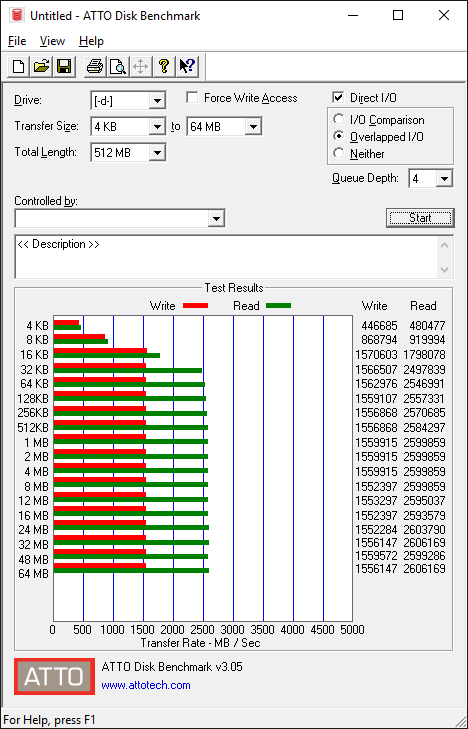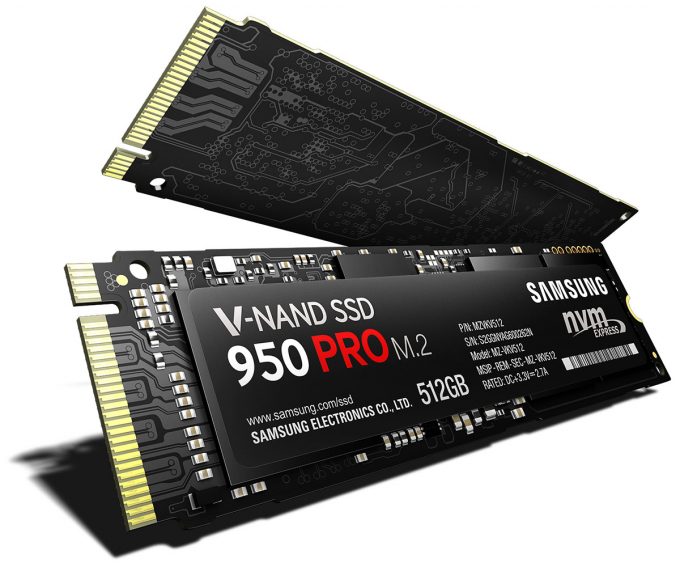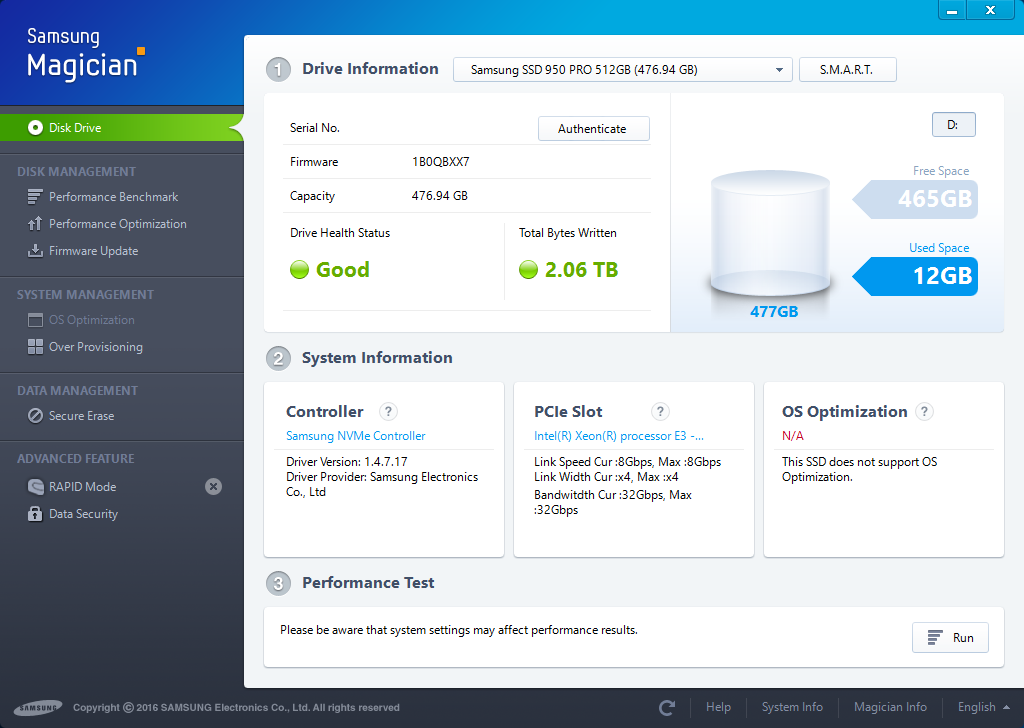- Qualcomm Launches Snapdragon 4 Gen 2 Mobile Platform
- AMD Launches Ryzen PRO 7000 Series Mobile & Desktop Platform
- Intel Launches Sleek Single-Slot Arc Pro A60 Workstation Graphics Card
- NVIDIA Announces Latest Ada Lovelace Additions: GeForce RTX 4060 Ti & RTX 4060
- Maxon Redshift With AMD Radeon GPU Rendering Support Now Available
Samsung 950 PRO M.2 PCIe Solid-State Drive Review

Remember the look of awe on our faces when the first SSDs hit the market? Over time, that awe began to dissipate, but when M.2-based models began to hit the market? It hit us right where we needed it. Samsung’s 950 Pro SSD is a shining example of what M.2 SSDs are capable of, so let’s check it out.
Page 2 – Tests Continued & Final Thoughts
AS SSD
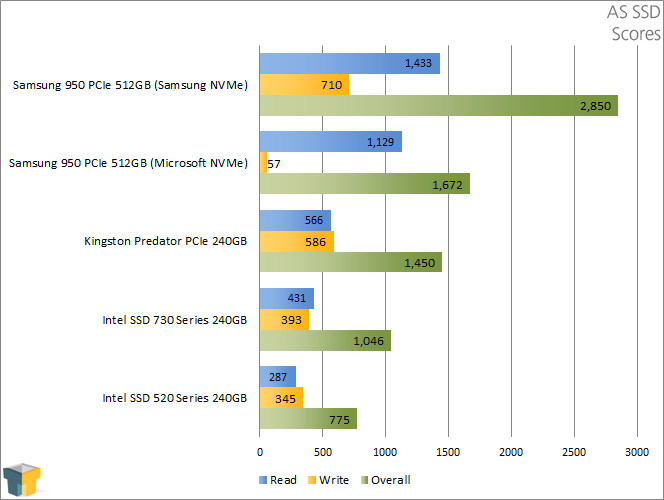
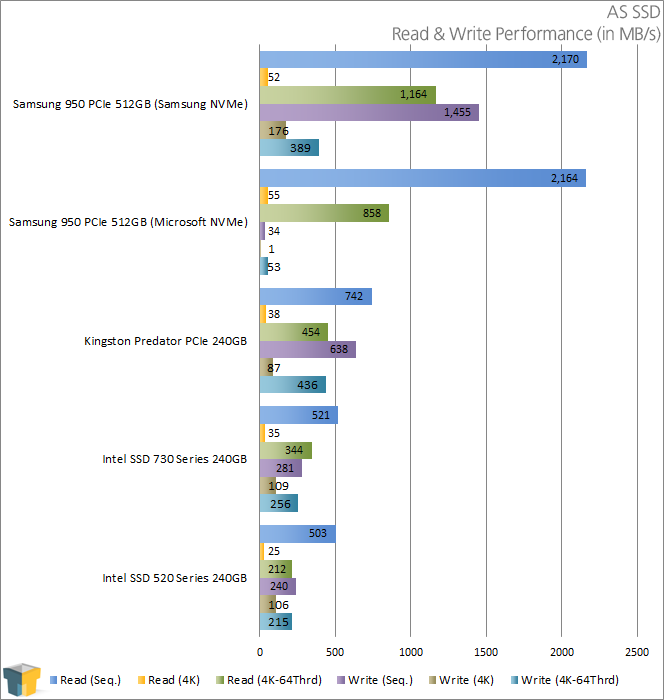
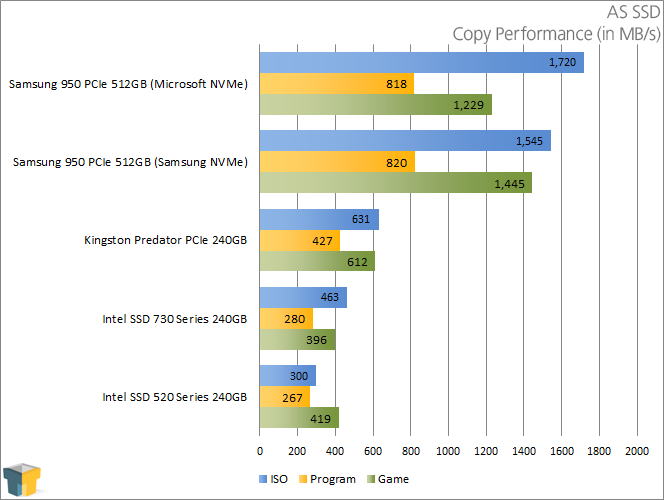
| AS SSD – Latencies | Read | Write |
| Intel 520 (240GB) | 0.110ms | 0.173ms |
| Intel 730 (240GB) | 0.032ms | 0.032ms |
| Kingston Predator (240GB) | 0.041ms | 0.047ms |
| Samsung 950 PRO (Microsoft NVMe) | 0.027ms | 2.670ms |
| Samsung 950 PRO (Samsung NVMe) | 0.023ms | 0.021ms |
Again the performance difference between Samsung and Microsoft NVMe drivers is severe, with throttling reducing the 950 Pro to actual HDD levels of performance and almost 3ms write latencies. However with Samsung’s driver the 950’s performance is not only back to normal but at the top of the charts, write performance is not only greatly improved but the 950 is able to more than double most results turned in by SATA-capped SSDs, and even six times the sequential write performance of the venerable Intel 520 SSD.
With the Samsung driver the final read, write, and overall scores are in a separate class entirely from the SATA drives and even the M.2 Predator, and the drive even posts the lowest read/write latencies of the entire group.
ATTO
There is no appreciable difference between the NVMe drivers here, but the same cannot be said for the performance gap between the 950 and other drives. The 950 Pro literally lives up to its performance specifications and delivers much higher performance even at smaller file sizes compared to other drives.
RAMDrive Robocopy
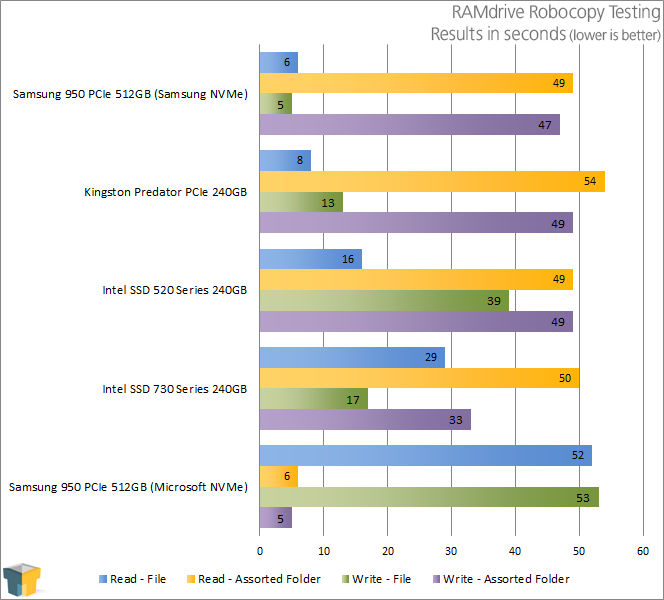
With Samsung’s driver the 950 Pro is able to write the nearly 10GB file in six seconds (1.57GB/s) and read it in five which works out to 1.87GB/s. Our test setup is very much work in progress, in future articles we already plan to switch to reporting the raw GB/s values instead of seconds for a cleaner graph. If you have any ideas for suitable SSD tests or know of a good disk I/O tracer that supports I/O recording for playback be sure to let us know in the comments!
dBpoweramp
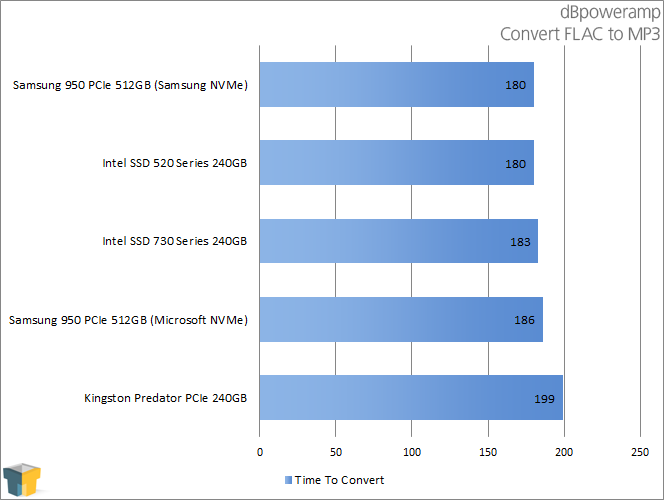
It appears even in this test we are completely CPU bound, a hex or octi-core CPU may give the 950 Pro sufficient room to outperform other drives but not even the benefits of NVMe’s lower CPU overhead allow it to drop below 180 seconds.
Final Thoughts
If you are in the market for a high-performance SSD the 950 Pro certainly fits the bill by surpassing traditional SATA SSDs by almost as much as said SSDs outdid the HDDs before them! Such performance in a tiny package of course comes with a price premium, and to ensure one actually gets that performance consumers will need to check laptops or motherboards first as not all M.2 slots are created equal.
Older mainboards may be limited to PCIe 2.0 or a x1 link to the M.2 slot, or may support PCIe 3.0 yet only have an x2 interface to the PCI Express bus. The 950 Pro will of course function in these slots but performance will be constrained if it is not a full PCIe 3.0 x4 capable M.2 slot. A UEFI or BIOS update may also be required to properly support NVMe devices, especially if desiring to make the 950 a system boot drive as would be the case with our ASUS Z97-A testbed.
Samsung’s Magician software is surprisingly useful in that it will indicate what the link speed, link width, and available bandwidth is for the M.2 slot the 950 Pro is currently using, making it easy for consumers to verify their system’s M.2 interface is not bottlenecking the drive.
It also has an option for a quick, easy way to secure erase the drive and check on important drive metrics. Our only real complaint is the software oddly does not report drive temperature. It does helpfully indicates what NVMe driver is in use; for reference we show what it looks like with Microsoft and Samsung’s NVMe driver each installed.
Unfortunately Samsung has thrown a new complication into the mix otherwise the 950 Pro would be a very easy recommendation for enthusiasts willing to pay the performance premium. The 950 includes built-in thermal management to throttle the controller and thereby prevent any damage from overheating, but this can cause erratic performance as demonstrated in the tests without Samsung’s custom NVMe driver. To exact the full performance from the 950 Pro users absolutely must install Samsung’s NVMe driver. We surmise it is specifically optimized for the 950 in order to reduce processing overhead for the 950’s controller and hence decrease instances of thermal throttling seen during heavy sustained writes such as our 45 minute PCMark 8 storage benchmark or the five minute sustained sequential Iometer write test.
As such we have to view the 950 Pro as purely an enthusiasts drive. So what do we mean by this? For the vast majority of enthusiast’s workloads it would see on a laptop or even desktops it should only infrequently reach a throttling condition, and if it does it shouldn’t be severe enough to become noticeable. But as our Iometer results indicate the 950 Pro simply isn’t designed to be an enterprise or workstation class SSD, any write-intensive very long duration workload like a 45 minute storage benchmark or simply several minutes of sustained max-speed writes will still cause the 950 Pro to begin throttling back performance.
Another way to look at it is this. Some budget SSDs (especially TLC SSDs) reserve a portion of the NAND as a fast write cache. Performance is very high until this small MLC or SLC fast-write cache is completely filled, then drive write performance drops sharply to a very low steady-state level until the SSD has free time to clear its fast-write cache. Typical users won’t write a sufficient amount of data in a short enough time to the drive to fill the fast-write cache so they never or very rarely notice the performance loss. The Samsung 950 Pro creates much the same effect with its controller temperature. The difference is it requires writing 1.5GB/s sustained to the drive for several minutes to force the 950 Pro to begin severely throttling. Constant small writes with short breaks (practically anything not a storage benchmark) is enough for the controller finish and cool down, so in typical consumer usage scenarios throttling isn’t likely to occur.
We would be remiss to not point out there is evidence that users can prevent throttling entirely by adding a tiny heatsink to the controller chip, but that’s not always possible given M.2 slot orientations or positioning nor is it recommended for casual users not familiar with PC hardware and the various types of thermal interface materials.
In the end, the Samsung 950 Pro is proof that good things can come in small packages. The 950 Pro is an ultra high-performance drive that ticks all the right boxes for enthusiasts that want the absolute best performance in the small M.2 form-factor. Results prove it is in a completely different league from SATA SSDs and even other AHCI M.2 SSDs.
While fast NVMe M.2 drives from other manufacturers are on the horizon and will start showing up later this year, currently the only way to obtain this level of performance would require switching to full size PCIe card SSDs or very uncommon 2.5″ U.2 models. Obviously neither of which are an option for laptops and ultraportables which leaves the 950 Pro in a unique position given its svelte M.2 2280 form-factor.
If you are in the market for a blazing fast enthusiast solid-state drive that decimates its competition and either can’t or don’t want to go the PCIe card route then Samsung’s 950 Pro 512GB is the clear answer. Just make sure to install Samsung’s NVMe driver to go along with it if you do!
Support our efforts! With ad revenue at an all-time low for written websites, we're relying more than ever on reader support to help us continue putting so much effort into this type of content. You can support us by becoming a Patron, or by using our Amazon shopping affiliate links listed through our articles. Thanks for your support!




